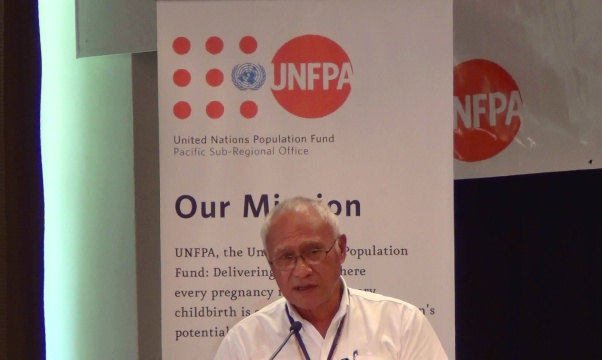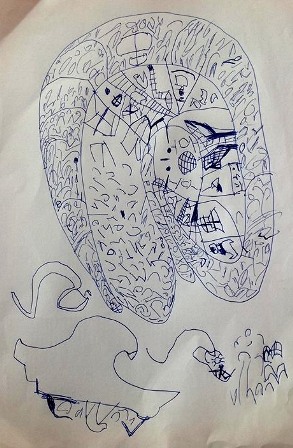A FRIEND of mine posted a picture this past weekend of the artwork by her five-year-old son who'd just been taught the formation of waves and was asked to draw his understanding of what he'd just learnt. Intriguingly, his world-view placed items closest to his heart within the waves.
The work by Ben Carling did not only capture the basics of wave formation but it would be safe to say he captured as well a phrase coined by the late Tongan academic, Professor Epeli Hau'ofa, to describe this region: ocean of islands. The photo was reminiscent of another construct, the moana methodology.

The concept is essentially about prophetic leadership in today's turbulent waters of modern challenges, like those that our island communities are dealing with - our small economic bases, the disenabling geographical realities synonymous with countries comprising small islands or atolls, the dwindling natural resources in the backdrop of increasing population; and/or resources which in most cases continue to be exploited like fisheries, because of the countries' inability to monitor their exclusive economic zones.
Moana is an ancient oceanic word meaning "ocean" - while depth and the largely mysterious underwater world is implicit when invoking moana (ocean), that its waters touches every island nation and continent speak also of interconnectedness.
The five oceanic systems - the Indian, Antarctic, Pacific, Atlantic and the Artic oceans - have their own characteristics but then they flow together to form one moana.
In this context, Dr Halapua encouraged parliamentarians to work together, that even with our country-specific interests and priorities, there were enough similarities in advantages, challenges and options of addressing these issues which could allow a collective development agenda.
"We cannot do our task separately, we need to pull together. It is the strength of our working together that will make the difference," Dr Halapua said.
In keeping with his analogy of the oceans, theoMoana speaks as well of a vaka, literally translated to mean "canoe". As a methodology, a vaka refers to a mechanism or platform on which the leadership then implements its plans.
"It is good that we are working together but what is it that we are working together for? It is about the sexual reproductive health and right - I am excited about it because the privilege of this here is we begin with a formation, if the formation is safe and healthy, the rest of our human development will be," Dr Halapua said.
"It is ours. When we know what is ours, we will understand what others give. What we have is for others and what others have is also for us."
The parliamentarians and partners of the United Nations Population Fund issued an outcome statement at the end of that meeting entitled Moana Declaration - which specified 18 items that the parliamentarians felt were essential areas of development that needed to be prioritised from the region's perspective, in relation to the International Conference for Population and Development's (ICPD) Program of Action (PoA).
Pacific leaders joined their global counterparts (179 countries in total) to sign up to the ICPD's 20-year PoA in 1994, in Cairo. The PoA as it is ends in 2014. The United Nations General Assembly voted in 2010 for the extension of the ICPD PoA. The last two years therefore has been about reviewing the PoA to ensure an informed updated agenda. The Moana Declaration was informed by results and lessons learnt from the Pacific review, and will be the submission of the region to a regional meeting later this month in Bangkok, as part of a global process towards the new PoA.
The Moana Declaration was the vaka that came out of the leaders' talanoa, an acknowledgement of the unique characteristics of our island communities: communities peopled by individuals as capable as any other human grouping but for whom, for the most part, cultural and faith-based considerations were still very much entrenched in their daily decision-making processes.
The declaration was not merely a call for help or understanding but rather a proposition for an alternative way of considering development as a tool for the improvement of lives of those who people this ocean of islands. The moana aspect of the declaration is reference to a completely different set of dynamics which suggests a shift from the propensity to apply development approaches that are not considerate of the duality of the Pacific person - the modern and traditional.
The typical Pacific individual is not only governed by state or parliamentary rule but for the most part, one's faith and cultural practices have a lot more influence in their behaviour and decision-making processes. This triangular oceanic governance is defined by Dr Halapua as the moana leadership - its centre being the people who anchor the interconnectedness.
UNFPA deputy executive director (program) Kate Gilmour, when discussing this triangular governance and influencers said faith and culture were important tributaries to the river of leadership.
"From a faith-based perspective, that's about congregation, still about people. From a cultural perspective it's about community, still about people. From a government perspective it's about constituents, still about people," Ms Gilmour said.
"And in that people-centeredness, the purpose of this discussion is to support you, as a means to an end. The only purpose that this discussion can be or should be held accountable is whether we change the lives of women, young people and of children - whether they are in congregation, in communities or as your constituencies, in regard to their inherent dignity."
Pacific leaders will sail their vaka to an Asia-Pacific gathering next week in its bid to ensure that the voices of Pacific peoples, including girls, women and young people, will be heard and considered for inclusion in the new global development agenda, beyond 2014 (when the ICPD comes to the end of its first 20 years) and beyond 2015 (when the Millennium Development Goals marks the end of its lifecycle).
We return to Mr Carling's representation of wave formation - never the same width and punctuated by various treasures in the mind of a five-year-old, his work is an apt illustration of our connectedness, that will make us stronger and we do have certain practices, like talanoa to reach consensus, that can be alternative pathways to enriching our lives collectively, coupled with Oceania nuggets of leadership that has brought us thus far.

The moana methodology can be a gift to the global stage of development agenda-setting, the Pacific's contribution to the determination of alternative ways of improving the lives of our peoples and as Reverend Dr Halapua reminded us, we build us a good foundation of sexual and reproductive health and rights, a healthy and productive populace naturally follows.
May we never forget that it is the individual - the believers, community members and voters - who is the inherent rights holder and to whom governments and development agenda processes are accountable to, not the parliament, religion or the culture but the person.
The inalienability of one basic human right was aptly described by Ms Gilmour who told participants: "(We) have no legitimate option but to uphold human rights indivisibly and universal as they are expressed in the Universal Declaration of Human Rights, as being at the heart of that which makes us human."

